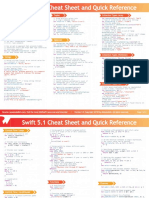0 ratings0% found this document useful (0 votes)
20 viewsUndestanding Modern JavaScript
Uploaded by
mrfixCopyright
© © All Rights Reserved
Available Formats
Download as PDF or read online on Scribd
0 ratings0% found this document useful (0 votes)
20 viewsUndestanding Modern JavaScript
Uploaded by
mrfixCopyright
© © All Rights Reserved
Available Formats
Download as PDF or read online on Scribd
You are on page 1/ 9
a davidlwebdev »
© JavaScript )
Understanding
MODERN
JAVASORIPT
. / .
ot What is ECMAScript? )
ECMAScriptis a scripting language specification and
it determines how JavaScript works and what new
features it should have. Features are usually released
incrementally each year to ensure smooth updates to
the JavaScript programming language.
The most notable release of the ES standard was done in the
year 2015, with the release of ES6, which brought a lot of the
amazing JavaScript features we use today in modern code.
This post will help you explore and understand the shifts in
the JavaScript programming language throughout the years,
showcasing key features that have been part of past releases.
Let’s get started!
ee ES6 (2015) ‘)
The biggest year for JavaScript, this release includes some
really important updates that any JS developer should know!
Key Features
The let & const keywords for variable declaration
Template Literals | Destructuring
Spread Syntax } New Array Iteration
Promises | Classes & Modules
oY
Arrow Functions | Default Parameters
This update changed JavaScript by a lot, so let’s see how it
compares to the old version (ES5 - Released in 20T1)
ES5 VS ES6
1. Template Literals
eae steeeC oe
let second = ‘webdev';
eRe) eo ae Co
amass Pert see.
2. Destructuring
const list = [4
ae st ae eCad
Caer eee a
t [one, two, ...rest] = list;
console. log(one, two, rest);
3. New Array Iteration
const list = [4, 5, 6];
Peres tcrr rreeo
for (i of list)
Corer
5
Embed expressions in
strings with a cleaner
syntax!
Unpack values from arrays or
properties from objects into
distinct variables! Heavily
used in React
Asimpler and more declarative
way to iterate over arrays.
ES7 (2016)
Key Features
a _
Array.prototype.includes()
ist list = ['bread', ‘cheese’, ‘ham']; Anew, easy way to
check if an array
yet) includes a certain
el h ea) value
Anew math operator which returns the
result of the first operand raised to the
power of the second operand
Next
ESS (2017)
Key Features
é
Object.values() & Object.entries()
const person = { name: ‘Matt’, age: 23 };
Pee CaS aee se CH eT STL
Pee en @ Same CD
@ ~
| Trailing Commas
a cant
A Trailing commas allow us to add new lines to
Crt UC aaan
an object without having to modify the
previous line since it already has acomma
Pee
=
| String .padStart() & padEnd() methods
4 >
Asynchronous Functions (Async/Await)
ES9 (2018)
Key Features
Asynchronous Generators & Iterators
a >
Object Rest & Spread Operators
SFL reas
st obj2 = { three: 30 }
An easier way to clone, combine
and work with objects in general!
st clone = { Shand
obj3 = { ...obj1, ...0bj2 }
Promise.prototype.finally()
- :
RegExp Features (Named Capture Groups, dotAll)
Ms ES10 (2019)
Key Features
Array.flat() & Array.flatMap()
a >
Object.fromEntries()
Create objects
from an array of
entries!
String -trimStart() & trimEnd() methods
i
Optional Catch Binding (Catch Block Error Param)
- ESM (2020)
Key Features
Private Class Variables
Presta Private class variables are
ag console.log(2022 - this.#birthyear declared using a hash in
i front of the variable or
function name. Accessing
const david = new Person()
david. age() them outside the class
console. log(david.#birthyear) will throw an error.
4
Promise.allSettled() method
i »
| String.prototype.matchAll()
Optional Chaining Operator
let car = { color: 'red' };
ae ese eee Tees Co
console. interiorColor);
Prevent errors in your code
by using optional chaining!
You might also like
- Unit1ECMAScript6pptx__2024_07_13_14_29_17 (4)No ratings yetUnit1ECMAScript6pptx__2024_07_13_14_29_17 (4)33 pages
- Lecture 7.2 - Introduction to Modern Javascript (4)-p1i71n6qb0edn1jii190mnd4No ratings yetLecture 7.2 - Introduction to Modern Javascript (4)-p1i71n6qb0edn1jii190mnd443 pages
- ES6 and Fundamentals of Web DevelopmentNo ratings yetES6 and Fundamentals of Web Development98 pages
- Dokumen - Pub - Javascript For Impatient Programmers Z 5657019100% (1)Dokumen - Pub - Javascript For Impatient Programmers Z 5657019872 pages
- Immediate download (Ebook) Get Programming with JavaScript Next - New features of ECMAScript 2015, 2016, and beyond by JD Isaacks ISBN 9781617294204, 1617294209 ebooks 2024100% (2)Immediate download (Ebook) Get Programming with JavaScript Next - New features of ECMAScript 2015, 2016, and beyond by JD Isaacks ISBN 9781617294204, 1617294209 ebooks 202467 pages
- JavaScript Essentials for Technical InterviewsNo ratings yetJavaScript Essentials for Technical Interviews226 pages
- Where can buy Get Programming with JavaScript Next New features of ECMAScript 2015 2016 and beyond 1st Edition Jd Isaacks ebook with cheap price100% (2)Where can buy Get Programming with JavaScript Next New features of ECMAScript 2015 2016 and beyond 1st Edition Jd Isaacks ebook with cheap price55 pages
- Unit 2 Advanced ES6 Features in JavaScript and Typescript100% (1)Unit 2 Advanced ES6 Features in JavaScript and Typescript20 pages
- USB 2.0 Multifunction Network Server: DN-13020 - DN-13023No ratings yetUSB 2.0 Multifunction Network Server: DN-13020 - DN-1302339 pages
- iOS and Android Game Development Tools Guide: 2016 EditionNo ratings yetiOS and Android Game Development Tools Guide: 2016 Edition11 pages







































































